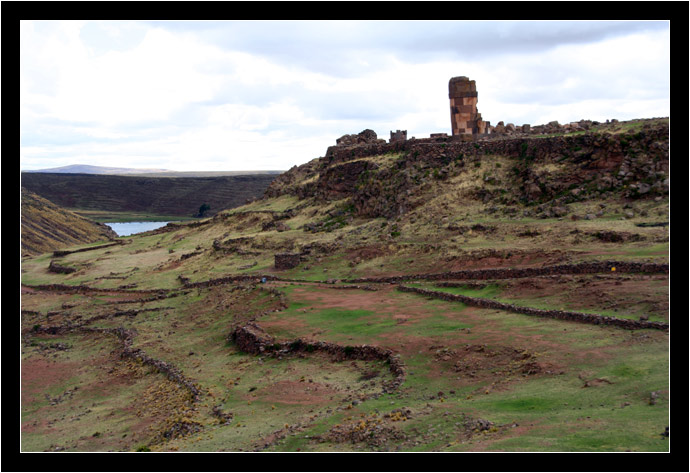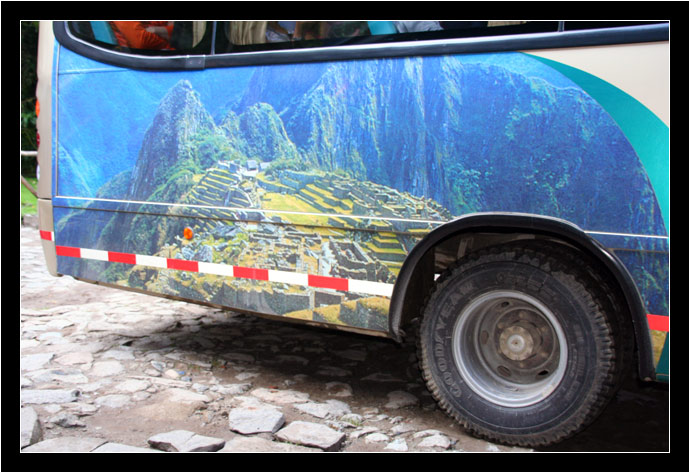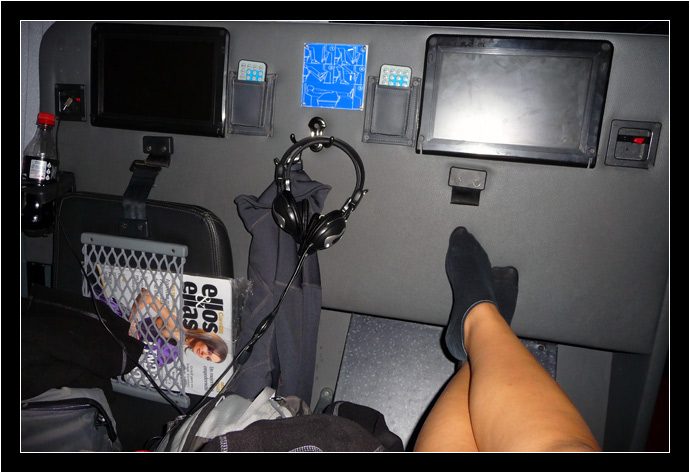
Before I started off on my first real trip out of the country – a college trip to Mexico in 1997 – our Spanish instructor gave us a little mental exercise in preparation for one of the essays we’d eventually be required to write. He asked us to take a few minutes to examine our preconceptions about the country we were about to visit so that we could see how well they matched up with reality.
Of course, we can’t help but do that when we travel, but turning it into a conscious effort allows us to see things that we wouldn’t otherwise.
Our recent trip through Peru last month was my fourth time in the country. With the exception of trekking in Colca Canyon, all the places Oksana and I visited were the same old places I’d been before. Trying to remember my original preconceptions of the country was futile; for the most part, I knew exactly what to expect.
Still, traveling with Oksana (on her first trip to Peru) allowed me to see the country through her eyes. I jotted down some notes, as I often do, about how Peru can be different from what you may expect.
Rocks

When people think of Peru, they probably think of ruins like Machu Picchu. Incan stonework is simply amazing – you hear about the mortarless walls that were created hundreds of years ago and are still so tightly aligned that you can’t even slip a razorblade between the individual rocks. When you explore places like Cusco or Ollantaytambo, you realize that’s not an exaggeration.
Peru is a bigger country than you might think, and the best way to get around is by bus. I’ve spent hours upon hours (perhaps literally days or weeks, when you factor in all four trips) staring out the windows and watching the countryside slide by. Throughout the Andes, along the altiplano, even in the coastal deserts, you can’t help but notice that Peru has… well, a shitload of rocks.
It’s no wonder the Incans were so good with stonework! Where other countries had lush forests with think trees to harvest for wood, they had nothing but a bunch of rock. Even today, you see it everywhere. Every rural village is constructed entirely of stone and mud. Thousands of miles of walls and terraces were created by carefully stacking together nothing by rocks. If Peru has a natural resource, it’s rock.

Transportation
When traveling in a foreign country, one can’t help but notice the differences in transportation. Usually it’s triggered by the onset of fear the moment you sit down in a taxi. Compared to the strict road rules of the United States, most other countries’ highways appear to operate with functional anarchy. Perhaps that’s why it’s so easy for me to find the differences.

Horns and Taxis
If you’re anywhere within half a mile of a road in Peru, you’ll hear the car horns. Drivers use them so often that, for awhile there, I thought they must be wired up to their brakes (or accelerators!), but after a few thousand blaring honks – i.e., about half an hour – I started to get a feel for why they use them.
In Lima, it’s almost always the taxis. I swear some cab drivers will literally honk as they approach every single pedestrian on the sidewalk. Side note: Lima has a population of 9 million.
For the obvious tourist – tall and pale, like me – it’s even worse. I can’t walk a block without three cabs honking from behind as they approach, slowing almost to a stop, and leaving over into the passenger seat with a suggestive shrug, “Need a lift?” A walk of a mile down a busy street will result in over 100 horns aimed squarely at us. That’s not an exaggeration.

I don’t know why, but before long, I became infuriated. “No. NO! If I wanted a cab, asshole, I’d put my damn hand out JUST LIKE A PERSON WHO WANTS A CAB!” I tried to examine my emotions to figure out why it bothered me so, and the best I could come up with is that it probably feels a lot like how an attractive woman feels on the street when sleazy guys constantly whistle at her for a reaction. Or perhaps how a celebrity feels when they can’t go anywhere without being inundated with autograph requests. It’s exhausting.
I think locals innately tune out the sound, but as someone raised in a country where we’re only supposed to use horns for warnings, I was constantly on edge. And not always without reason: Once, while Oksana and I were trying to cross a busy roundabout, an opportunistic cab driver thought we just might need a ride. Instead of looking to see if we were doing anything at all to get his attention, he honked, slammed on his brakes, and came to a stop right in front of Oksana. In the heavy traffic, Oksana was timing her walk to pass just behind the taxi, so she almost smacked right into the back of his car. Of course, the traffic behind the cab wasn’t expecting him to stop, either, which suddenly put Oksana in real danger. She made a fist and slammed it into his rear quarter-panel. He got the point and moved on.
In other, smaller towns in Peru, like Nazca, the horns serve an entirely different purpose! They are a substitute for stop signs.
I mean, really! Why should the Peruvian department of transportation waste money on stop signs when drivers can just simply honk their horns as they approach every intersection?
Seat Belts
There must be a new law about drivers wearing seat belts in Peru. Most of the cab drivers we had would stretch the belt across their laps… and let it rest there, unbuckled. Think about that for a second. Seat belts automatically retract, don’t they? They would have had to have actively tampered with the mechanism so that they could leave the belt one inch from the clasp. If they’re not going to click it, there’s no reason to pull it down in the first place… unless you’re trying to keep up appearances.
Now, why they won’t take it the extra inch and clip it in, well, that makes no sense to me. Maybe the horns do work better than stop signs.
Traffic Lights & Crosswalks
Not long before we left the States, when I was still able to keep up with my RSS feeds, a concept design for a new stoplight went viral for a short time. Perhaps you saw it, too.
In Lima, I was surprised to see that they had just unveiled their new “intelligent stoplight” system that essentially one-upped that idea. Each stoplight had a countdown timer, whether it was on red, yellow, or green. Pull up to any stoplight and you knew exactly how long you had to wait.

And while that more abstract design passed around the internet was kind of cool in a let’s-mimic-those-computer-progress-bars-we’re-so-fond-of kind of way, the lights in Peru used a far more intuitive system. They simply counted down the time in seconds.
Crosswalks had countdown timers, too, with the audible chirping sounds to let you (and blind people) know that the light had changed. We’ve got plenty of those in the US; I wonder why no one ever took that (logical) design and applied them to the stoplights.
Buses
I think the buses have come a long way since my first visit to Peru, but that may just be because I was on a tighter budget the first few visits. On this trip, Oksana and I experienced the full range on offer.
The first was easily the worst. We left Ecuador from Cuenca on a border-crossing trip in the middle of the night. The Ecuador portion was fine, at least until we got to the immigration office on the border. There, at 2am, we stood in line a full hour before the officer behind the glass deemed it an appropriate time to start working. Once we’d received our exit stamps, we switched over to a Peruvian bus company, CIFA, for the next few hours.
Don’t ever ride on CIFA.
Even though this bus was included in our original ticket price, somehow they didn’t have enough seats for everyone. The attendant evicted someone for Oksana, but told me to go stand in the back of the bus. “Why can’t I at least stand next to my wife?” I asked. He told me, “because of the police.” Hey. Illegally over-booking your bus doesn’t sound like my problem. Whatever. I still had to stand for the next three hours, 4am to 7am, until we reached Máncora.
The ride out of Máncora, to Lima, was the complete opposite – easily the best bus we had in Peru! The seats reclined all the way to 180 degrees. Blankets, pillows, and meals were served on the bus. Magazines were tucked into the seatbacks, and if we got bored with those, we just picked up our headphones and plugged them into full-fledged DVRs loaded down with movies and music. If only the inattentive mother in front of us would have reigned in her kids…

We quickly learned which bus companies to trust. CIVA, the one with the DVRs, was our favorite, but we also took Cruz del Sur more than a couple times (Cruz del Sur claimed to have wi-fi whenever they were in a 3G coverage zone, but I was never able to get it to work.)
Another interesting thing about the higher classes of bus service is the security methods they now employ. It starts when you check your luggage, usually from within the terminal. Instead of just tossing it onto the bus, they’ll give you an official luggage tag and won’t release your backpack at the destination until you produced the matching ticket.
Then, before you get on the bus, you have to show your passport. Not only that, but a couple times we were fingerprinted, too! And then, once everyone is finally seated on the bus, an attendant will walk the aisles with a video camera and shove it into everyone’s faces, one seat at a time.
At first, I wondered if all these security measures were to discourage the types of problems Peru had in the past. Hijacked buses, the Shining Light terrorist group, stuff like that. Later we realized it was most likely a form of identification in case of an accident.
Drinks
On my first visit to Peru, I got into a conversation with a nice older gentleman while we slowly putted across Lake Titicaca on a day tour. I don’t remember how it got started (we may have passed a Pepsi billboard as we left the harbor), but he asked me if I preferred Coca-cola or Pepsi. I told him Coke, of course.
It was the right answer. Pepsi had recently tried started a big marketing push in Peru and he said that they didn’t have a chance of competing with Coca-cola. He said that if Peruvians had their way, they’d drink Coca-cola with every meal. Well, except for one specific dish: Cevíche (raw fish/seafood soup.)
What do they drink with cevíche? Bubblegum- (tutti-frutti-) flavored Inca Kola!
I thought he was insane. At least until we reached Máncora and found ourselves eating at a cevichería with two Colombian friends. Believe it or not, the only drink they had was Inca Kola. I told everyone at the table the story I’d heard 13 years before and we decided to risk sharing a 2-liter bottle.
You know what? Somehow it works! The super-sweet taste of the Inca Kola counters the fishy/lemony taste of the cevíche and sort of resets the palate for the next bite. Shocked, I was!
Speaking of soft drinks, Diet Coke is my vice. You can find it Peru (labeled as Coca-Cola Light, but you can simply ask for “Coca Light”), but Coke Zero is much more common now. Interestingly, Diet Coke tastes quite different to me down here; it almost has a “fruity” aftertaste. And it’s not just the bottled variety that tastes different, either; even the fountain soda at McDonald’s tasted a little… off. My guess? It’s the water.
Dogs
There are lots of dogs roaming the streets of Peru. Often, they’re fairly skittish, always looking for garbage and handouts. People in Peru seem to tolerate them well enough, though obviously I never saw any evidence of animal control (or of birth control, for that matter.)
A certain type definitely stands out: The hairless Peruvian dog! Oh, what an ugly creature – the poor things – I can’t imagine ever petting one. What’s there to pet, other than gray, mottled (and sometimes sunburned) skin? Okay, some have scraggly mohawks; I guess you could scratch between their ears…
As comically horrible as these dogs looked, I was glad to see people taking care of them in Máncora. I’ll bet those dogs enjoyed the ridiculous sun-blocking sweaters they wore on their backs. At least a little bit.
Books
This isn’t specific to Peru, but rather most of Latin America. Every time I entered a book store, I would be shocked anew by the prices. Okay, hardback books are expensive even in the US, but can you imagine paying $22 for a mass-market paperback? Seriously, twenty-two United States dollars for the latest John Grisham novel or whatever? It doesn’t matter if the book is in English or Spanish, the prices are all pretty much the same. Big trade paperbacks, like the Twilight novels for instance, can be even more expensive!
Paper and ink are cheap, so I can only imagine that book prices are so high because of supply and demand issues. If very few books are printed, the cost of printing each one would be higher.
Makes me wonder about the country’s literacy rate. Unless the libraries do amazing business, I can’t imagine anyone but the wealthiest people reading for pleasure. Which is a shame. I would wager I’ve learned far more in my life, reading for pleasure, than I have through traditional (school) methods.
Gas
Gas prices in Peru, unlike in Ecuador, are much closer to the world average, I think. It was around $4 per gallon or so while we were there. What’s surprising is that, with the exception of luxury-class buses, the price of transportation wasn’t that much more expensive. I guess that means the profit margins are slimmer.
Gasoline prices remind me of the gas stations. Each and every one had all sorts of signs telling you to turn off your engines before pumping gas, just like back home. I never saw a single driver pay attention to those signs. In fact, most of their gas caps had locks on them and the driver would have to hand the attendant his keys to open it. Get this: Even when the keys were removed from the ignition, the cars’ engines continued to run! All of them!
Also, from a language perspective, I could write a ton about how each Latin American country has its own Spanish idiosyncrasies (This one calls an avocado a “palto,” while that one says it’s an “aguacate.” Here it’s “mani” while in Mexico it’s “cacahuates,” etc., etc.) That could be a whole blog entry of its own (and probably a boring one, too), but I thought it worth mentioning that in Peru they call the gas stations, “grifos.” No idea why. Just wanted to mention it because that word once stumped even our Spanish instructor.
T-Shirts
I figured maybe if I sat down and thought about it for awhile, I could think of many innovative ways in which Peruvians use common household items for secondary, novel purposes. For instance, more than once I saw an old T-shirts used as a doormat: In hostels, on buses, etc. “Just wipe your feet on the shirt, please!”
So, I sat down and thought about it and all I could remember was the T-shirt thing.

I totally forgot about the beeping! I’ve now realized that in Chile and here in Argentina, walking the sidewalks is so much more peaceful!
Also, I remember a ride in Huanchaco, Peru where our driver literally honked at anyone we passed. There was no need to warn them and no need to want to pick them up since we were occupying his vehicle. Maybe it was a nasty habit he had developed. What made the ride even more funny was that his horn didn’t honk but played different sirens. It got old REAL fast.
Grifo in Castilian means pump or tap hence the word used as a place to fill up a gas tank. If your Spanish teacher didn’t know that you might want to find another. Your observations on Peru are humorous yet insightful. Wish there was a way to stop the ignorance of the taxi driver’s honking.